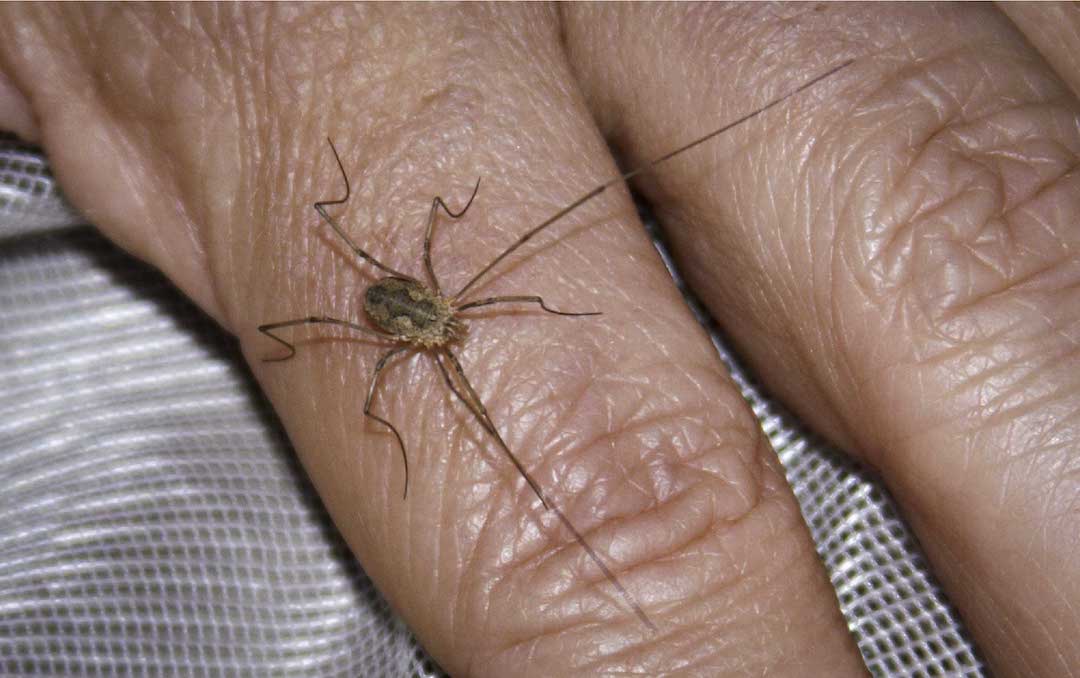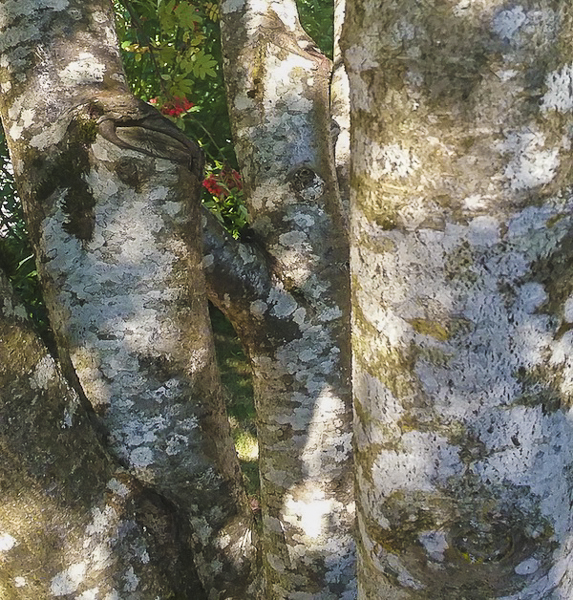the Harvestman: when a "spider" is not a spider
by Thomas and Sara Noland

Harvestman. photo by Liam Steele, CC by 4.0
the harvestman: when a "spider" is not a spider
by Thomas and Sara Noland
The brick façade next to our front door is a favorite hangout for spiders and moths. During the late summer and fall months especially, it’s common to find two or three different kinds of moths resting there with their wings spread out flat against the brickwork — probably attracted to the porch light overnight. One particular type of eight-legged visitor can often be found clinging to the bricks as well. This visitor has an oval-shaped, gray-brown body that looks too small for the span of its super long black legs. This is the harvestman, and it’s actually not a spider at all.

Closeup of a harvestman taken under a stereomicroscope at 20x magnification. The two dark-colored eyes are clearly visible. You can also see a “stump” where this harvestman lost a leg (but is doing fine without it). The two short appendages sticking out in front are the pedipalps. To get the harvestman to hold still for this photo, we put her in the refrigerator for a few minutes. After a couple of minutes under the stereomicroscope lamp, she woke up and we put her back outside. photo by Thomas Noland
You might know them as harvestmen, daddy long-legs, or shepherd spiders. They are arachnids but are not closely related to spiders. Unlike true spiders, which have a distinct cephalothorax and abdomen, the harvestman appears to have only one fused body part to which the legs are attached. While spiders have multiple pairs of eyes, the harvestman has only two eyes. There are over 6,000 known species of harvestmen worldwide, although it is thought by many experts that the number may be as high as 10,000 with all the species that are yet to be discovered. Washington state has over 50 known harvestman species, with two new local species only recently discovered.
Harvestmen get their name from the fact that they appear in late summer and early fall around harvest time. They are also known as shepherd spiders because the males guard the females while she is laying her eggs. Some people also thought the harvestman’s long legs resembled the stilts that shepherds used to stand on while watching their flocks. The name of the family of harvestmen, Opiliones, means “shepherd.” You might hear the common name “daddy long-legs” also used for the cellar spider or crane fly.

What does it feel like to let a harvestman crawl on your hand? It tickles. This adult has a wavy pattern with shades of gray on its body. The harvestman’s two eyes can discern light and dark but no other details, so it uses the two very long legs sticking out front like an insect uses its antennae to sense the world around it. The lower part of each leg, called the tarsus, is very flexible and can grab onto twigs and other objects, allowing the harvestman to even hang upside down when needed. photo by Thomas Noland
Myth: Daddy-longlegs would be deadly but…
Harvestmen have no venom glands and they don’t spin silk. They do not live in webs or nests. Scientists have recently discovered that pedipalps (appendages near the mouth) of some species of harvestmen secrete a sticky substance that helps them capture live prey.
Harvestmen Use Glue to Capture Prey
Using mouth parts called chelicerae, which are similar to tiny claws, they tear off chunks of prey to eat. Some harvestmen are omnivorous, eating small insects, plants, and fungi, while others are scavengers that consume dead animals or bird droppings and other fecal material. They are very fastidious, drawing their legs through their mouth parts to clean them after eating. They are nocturnal hunters and use camouflage to stay concealed during the day. You might find them under leaf litter in your garden, or hiding in plain sight on a brick wall.
Harvestmen are preyed upon by some mammals and amphibians as well as spiders. They use smelly chemicals secreted from their legs to ward off predators, as well as bobbing motions to confuse predators when they attack. Like lizards shedding a tail, the harvestman can even shed a leg that wiggles and distracts predators as the harvestman escapes. The leg does not regrow, and it’s common to find harvestmen with a missing appendage or two. They can even feign death to avoid being eaten.
If you ever find what looks like a patch of brown hair on a rock or tree trunk, you might be looking at the combined legs of hundreds of harvestmen huddled together. This behavior may be used to regulate body temperature, or it could be another way to fend off predators.
For more on the topic, here’s a couple of videos:
from Burke Museum
from Animal Fact Files

Sara and Thomas Noland are naturalists who live in Everett, Washington. They live in a tiny house with many cats but are fortunate to have a big yard with lots of trees, birds, and lichens. They frequently take field trips to enjoy and photograph mountains, beaches, and deserts, as well as enjoying the creatures in their own neighborhood.
Table of Contents, Issue #13, Autumn 2021
Rackny the Jumping Spider
by Adelia Ritchie, PhDphoto by Erik Karits on Unsplashphoto by Erik Karits on Unsplashby Adelia Ritchie, PhDI never used to like spiders. I mean, they’re creepy, they have too many legs, some of them can bite, and every week I have to get the ladder and the...
Web Masters
by Barb Erickson photos by Barb Ericksonby Barb Erickson photos by Barb EricksonThey’re everywhere! They’re everywhere! In what seems an appropriate time and place, I love to ramble off this line, in a high-pitched, cartoon-character voice. As my husband remembers at...
Jumping spider
by Bob Gillespiephoto by Dustin Humes @dustinhumes_photography via Unsplashphoto by Dustin Humes @dustinhumes_photography via Unsplashby Bob GillespieMost of us probably began to appreciate spiders when we read Charlotte’s Web. Charlotte was a rather ingenious...
Spiderlings
by Adria Magrath photos by John F. Williams except as notedby Adria Magrath photos by John F. Williams except as notedSometimes, nature calls to question one’s initial reflexes. When first noticing unexpected movement in peripheral, more primitive vision, such as...
Poetry-13
Autumn 2021photo by John F. Williamsphoto by John F. WilliamsAutumn 2021Before we begin our spider poetry, here is a poetic tribute to one of our Salish Magazine authors who passed away this year.They’re Just Leaves A poem in memory of Todd Ramsey, 1950-2021 ...
PLEASE HELP SUPPORT
SALISH MAGAZINE
DONATE
Salish Magazine contains no advertising and is free. Your donation is one big way you can help us inspire people with stories about things that they can see outdoors in our Salish Sea region.
We also don't advertise Salish Magazine, so please spread the word of this online resource to your friends and colleagues.
Thanks so much for your interest and your support.
We also don't advertise Salish Magazine, so please spread the word of this online resource to your friends and colleagues.
Thanks so much for your interest and your support.





